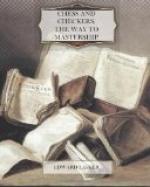White starts his mating attack with (1) Kt-f6. This threatens the sacrifice of the Queen on h6 followed by R-g8 mate. White’s Knight move can hardly be called a sacrifice as it is quite evident that Black cannot take the Knight on account of Qxh6+, Kt-h7; Q-g7 mate. The only way to parry White’s threat is (1) ..., Kt-g6. However, this helps only momentarily as White continues (2) R-h3 threatening Q-g5, Rxh6+ and Qxh6 mate, a threat against which Black has no defense. White can very nearly force the mate by sacrificing his Queen on h6 instead of the Rook. But after (3) Qxh6, Pxh6; (4) Rxh6+, K-g7; (5) R-h7+, K-f8; (6) R-h8+ Black does not take the Rook as White would like him to do to enable the mate R-g8, but he goes back to g7 with the King and White could not do any better than draw by perpetual check on h7 and h8.
+---------------------------------------+ 8 | #R | | | #Q | | #R | #K | | |---------------------------------------| 7 | | #B | | | | #P | #P | #P | |---------------------------------------| 6 | #P | #Kt| #Kt| | #P | | | | |---------------------------------------| 5 | | #P | #P | #P | ^P | | | | |---------------------------------------| 4 | | | | ^P | | ^P | | | |---------------------------------------| 3 | | | ^P | ^B | | ^Kt| | | |---------------------------------------| 2 | ^P | ^P | | ^Kt| | | ^P | ^P | |---------------------------------------| 1 | ^R | | | ^Q | | ^R | ^K | | +---------------------------------------+ a b c d e f g h
Diagram 36.
In the position of Diagram 36 White can make an attack which will recall somewhat the play shown in connection with Diagram 25. (1) Kt-g5 would not lead to anything, as Black could defend himself by P-g6 or P-h6. White has a much more direct way to attack the black King. This is by the sacrifice (1) Bxh7+. After Kxh7; (2) Kt-g5+, K-g8; (3) Q-h5 Black can protect the mate only by sacrificing his Queen for White’s Knight. For (3) ..., R-e8 with the view to escape with the King to e7 via f8 if attacked by Q-h7 and Q-h8 would be rendered futile by White through (4) Qxf7+, K-h8; (5) Q-h5+, K-g8; (6) Q-h7+, K-f8; (7) Q-h8+, K-e7; (8) Qxg7 mate. Before making the sacrifice of the Bishop White will, of course, have to make sure that Black cannot save himself by evading altogether the attack which is threatened through Q-h5. Black could, indeed, avoid this variation by going with the King to g6 on the second move instead of g8. But in this case too White has a winning continuation. He would play (3) Q-g4 threatening to win Black’s Queen by the discovered check Ktxe6. If Black moves the Queen, then White gives the discovered check in any case forcing the King to h7 and leading over to the variation which was originally intended. If, on the other hand, Black tried (3) ..., P-f5, attacking White’s Queen and thereby rendering the discovered check ineffective, White would first take the Pawn en passant and after (4) Pxf6, Kxf6 the Queen mates on e6.




